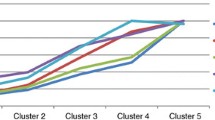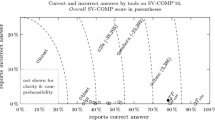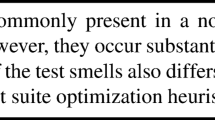Abstract
Software-intensive systems have been growing in both size and complexity. Consequently, developers need better support for measuring and controlling the software quality. In this context, software metrics aim at quantifying different software quality aspects. However, the effectiveness of measurement depends on the definition of reliable metric thresholds, i.e., numbers that characterize a metric value as critical given a quality aspect. In fact, without proper metric thresholds, it might be difficult for developers to indicate problematic software components for correction, for instance. Based on a literature review, we have found several existing methods for deriving metric thresholds and observed their evolution. Such evolution motivated us to propose a new method that incorporates the best of the existing methods. In this paper, we propose a novel benchmark-based method for deriving metric thresholds. We assess our method, called Vale’s method, using a set of metric thresholds derived with the support of our method, aimed at composing detection strategies for two well-known code smells, namely god class and lazy class. For this purpose, we analyze three benchmarks composed of multiple software product lines. In addition, we demonstrate our method in practice by applying it to a benchmark composed of 103 Java open-source software systems. In the evaluation, we compare Vale’s method to two state-of-the-practice threshold derivation methods selected as a baseline, which are Lanza’s method and Alves’ method. Our results suggest that the proposed method provides more realistic and reliable thresholds, with better recall and precision in the code smell detection, when compared to both baseline methods.









Similar content being viewed by others
Notes
References
Abilio, R., Vale, G., Oliveira, J., Figueiredo, E., Costa, H. (2014). Code smell detection tool for compositional-based software product lines. In Proceedings of the 5th Brazilian Conference on Software: Theory and Practice (CBSoft), Tools Session (pp. 109–116).
Abilio, R., Padilha, J., Figueiredo, E., Costa, H. (2015). Detecting code smells in software product lines: An exploratory study. In Proceedings of the 12th International Conference on Information Technology: New Generations (ITNG) (pp. 433–438).
Abilio, R., Vale, G., Figueiredo, E., Costa, H. (2016). Metrics for feature-oriented programming. In Proceedings of 7th International Workshop on Emerging Trends in Software Metrics (WETSoM) (pp. 36–42).
Alves, T., Ypma, C., Visser, J. (2010). Deriving metric thresholds from benchmark data. In Proceedings of the 26th International Conference on Software Maintenance (ICSM) (pp. 1–10).
Apel, S., Kästner, C., Lengauer, C. (2009). FeatureHouse: language-independent, automated software composition. In Proceedings of the 31st International Conference on Software Engineering (ICSE) (pp. 221–231).
Batory, D., & O’Malley, S. (1992). The design and implementation of hierarchical software systems with reusable components. ACM Transactions on Software Engineering Methodology, 1(4), 335–398.
Brereton, P., Kitchenham, B., Budgen, D., Tumer, M., & Khalil, M. (2007). Lessons from applying the systematic literature review process within the software engineering domain. Journal of Systems and Software (JSS), 80(4), 571–583.
Chidamber, S., & Kemerer, C. (1994). A metrics suite for object oriented design. IEEE Transactions on Software Engineering, 20(6), 476–493.
Coleman, D., Lowther, B., & Oman, P. (1995). The application of software maintainability models in industrial software systems. Journal of Systems and Software, 29(1), 3–16.
Concas, G., Marchesi, M., Pinna, S., & Serra, N. (2007). Power-laws in a large object-oriented software system. IEEE Transactions on Software Engineering, 33(10), 687–708.
Dumke, R., & Winkler, A. (1997). Managing the component-based software engineering with metrics. In Proceedings of the 5th International Symposium on Assessment of Software Tools and Technologies (SAST) (pp. 104–110).
Erni, K., & Lewerentz, C. (1996). Applying design-metrics to object-oriented frameworks. In Proceedings of the 3rd International Symposium on Software Metrics (METRICS) (pp. 64–72).
Fenton, N. (1991). Software metrics: a rigorous Approach (pp. 28–37). London: Chapman-Hall.
Fernandes, E., Oliveira, J., Vale, G., Paiva, T., Figueiredo, E. (2016). A review-based comparative study of bad smell detection tools. In Proceedings of the 20th International Conference on Evaluation and assessment in software engineering (EASE). Limerick, 1–3 June 2016.
Fernandes, E., Vale, G., Sousa, L., Figueiredo, E., Garcia, A., Lee, J. (2017). No code anomaly is an island: anomaly agglomeration as sign of product line instabilities. In Proceedings of the 16th International Conference on Software Reuse (ICSR), pp. 48–64.
Ferreira, K., Bigonha, M., Bigonha, R., Mendes, L., & Almeida, H. (2012). Identifying thresholds for object-oriented software metrics. Journal of Systems and Software, 85(2), 244–257.
Ferreira, G., Gaia, F., Figueiredo, E., & Maia, M. (2014). On the use of feature-oriented programming for evolving software product lines: a comparative study. Science Computer Programming, 93(1), 65–85.
Figueiredo, E., Cacho, N., Sant’Anna, C, Monteiro M, Kulesza U, Garcia A, Soares S, Ferrari F, Khan S, Castor Filho F, Dantas F (2008) Evolving software product lines with aspects: an empirical study on design stability. In: Proceeding of the 30th iInternational Conference on Software Engineering (ICSE) (pp. 261–270). Leipzig: IEEE Computer Society.
Fowler, M. (1999). Refactoring: improving the design of existing code. Reading: Addison Wesley.
French, V. (1999). Establishing software metric thresholds. In Proceedings of the 4th International Workshop on Software Measurement (IWSM).
Gamma, G., Helm, R., Johnson, R., & Vlissides, J. (1995). Design patterns: elements of reusable object-oriented software. Reading: Addison-Wesley.
Heitlager, I., Kuipers, T., & Visser, J. (2007). A practical model for measuring maintainability. In Proceedings of the 6th International Conference on the Quality of Information and Communications Technology (QUATIC) (pp. 30–39).
Herbold, S., Grabowki, J., & Waack, S. (2011). Calculation and optimization of thresholds for sets of software metrics. Empirical Software Engineering, 16(6), 812–841.
Kitchenham, B., & Charters, S. (2007). Guidelines for performing systematic literature reviews in software engineering. EBSE Technical Report, Keele University.
LabSoft (2017). http://labsoft.dcc.ufmg.br/doku.php?id=%20about:spl_list.
Lanza, M., & Marinescu, R. (2006). Object-oriented metrics in practice: using software metrics to characterize, evaluate, and improve the design of object-oriented systems. Berlin Heidelberg: Springer-Verlag.
Lima, E., Resende, A., & Lethbridge, T. (2016). The uncomfortable discrepancies of software metric thresholds and reference values in literature. In Proceedings of the 6th International Conference on Software Engineering Advances (ICSEA) (pp. 1–9).
Lorenz, M., & Kidd, J. (1994). Object-oriented software metrics. New York: Englewood Cliffs.
Louridas, P., Spinellis, D., & Vlachos, V. (2008). Power laws in software. ACM Transactions on Software Engineering Methodology, 18(1), 1–26.
Marinescu, R. (2004). Detection strategies: metrics-based rules for detecting design flaws. In Proceedings of the 20th International Conference on Software Maintainability (ICSM) (pp. 350–359).
McCabe, T. (1976). A complexity measure. IEEE Transactions on Software Engineering, 2(4), 308–320.
Mori, A., Vale, G., Viggiato, M., Oliveira, J., Figueiredo, E., Cirilo, E., Jamshidi, P., Kastner, C. (2018) Evaluating domain-specific metric thresholds: an empirical study. International Conference on Technical Debt (TechDebt).
Munro, M. (2005). Product metrics for automatic identification of “bad smell” design problems in java source-code. In Proceeding of the 11th international software METRICS symposium (METRICS) (pp. 1–9).
Nejmeh, B. (1988). NPATH: A measure of execution path complexity and its applications. Communications of the ACM, 31(2), 188–200.
Oliveira, P., Valente, M., Lima, F. (2014). Extracting relative thresholds for source code metrics. In Proceedings of the 18th International Conference on Software Maintenance and Reengineering (CSMR) (pp. 254–263).
Padilha, J., Pereira, J., Figueiredo, E., Almeida, J., Garcia, A., Sant'Anna, C.. (2014) On the effectiveness of concern metrics to detect code smells: an empirical study. In Proceedings of the 26th International Conference on Advanced Information Systems Engineering (CAiSE).
Perkusich, M., Medeiros, A., Silva, L., Gorgônio, K., Almeida, H., Perkusich, A. (2015). A Bayesian network approach to assist on the interpretation of software metrics. In Proceedings of the 30th Symposium on Applied Computing (SAC) (pp. 1498–1503).
Riel, J. (1996). Object-oriented design heuristics. Boston: Addison-Wesley.
Schulze, S., Apel, S., Kastner, C. (2010). Code clones in feature-oriented software product lines. In Proceedings of the 9th International Conference on Generative Programming and Component Engineering (GPCE) (pp. 103–112).
Software Engineering Institute – SEI (2016). http://www.sei.cmu.edu/productlines/
Spinellis, D. (2008). A tale of four kernels. In Proceedings of the 30th International Conference on Software Engineering (ICSE) (pp. 381–390).
SPL2GO (2015). http://spl2go.cs.ovgu.de.
Tempero, E., Anslow, C., Dietrich, J., Han, T., Li, J., Lumpe, M., Melton, H., Noble, J. (2010). Qualitas Corpus: A curated collection of Java code for empirical studies. In Proceedings of 17th the Asia-Pacific Software Engineering Conference (APSEC) (pp. 336–345).
Vale, G., & Figueiredo, E. (2015). A method to derive metric thresholds for software product lines. In Proceedings of the 29th Brazilian Symposium on Software Engineering (SBES) (pp. 110–119).
Vale, G., Albuquerque, D., Figueiredo, E., Garcia, A. (2015). Defining metric thresholds for software product lines: a comparative study. In Proceedings of the 19th International Software Product Line Conference (SPLC) (pp. 176–185).
Vasa, R., Lumpe, M., Branch, P., Nierstrasz, O. (2009). Comparative analysis of evolving software systems using the Gini coefficient. In Proceedings of the 25th International Conference on Software Maintenance (ICSM) (pp. 179–188).
Veado, L., Vale, G., Fernandes, E., Figueiredo, E. (2016). TDTool: threshold derivation tool. In Proceedings of the 20th International Conference on Evaluation and Assessment in Software Engineering (EASE), Tools Session (Article No. 24).
Acknowledgments
This work was partially supported by CAPES, CNPq (grant 424340/2016-0 and 290136/2015-6), and FAPEMIG (grant PPM-00651-17).
Author information
Authors and Affiliations
Corresponding author
Rights and permissions
About this article
Cite this article
Vale, G., Fernandes, E. & Figueiredo, E. On the proposal and evaluation of a benchmark-based threshold derivation method. Software Qual J 27, 275–306 (2019). https://doi.org/10.1007/s11219-018-9405-y
Published:
Issue Date:
DOI: https://doi.org/10.1007/s11219-018-9405-y




